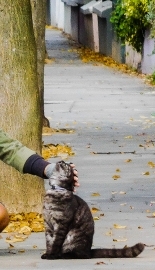Adam Yamey's Blog: YAMEY, page 145
November 7, 2021
The feel of fur
November 6, 2021
Leopoldstadt by Tom Stoppard
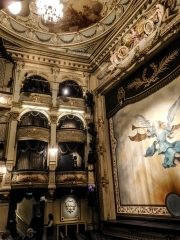 Wyndhams Theatre, London
Wyndhams Theatre, LondonI HAVE WATCHED AND GREATLY enjoyed many plays by Tom Stoppard. So, it was with high expectations and great excitement that I booked good tickets for his latest play, “Leopoldstadt”, which is about a tragic period during Austria’s history, a time that interests me greatly. The play follows the history of a Jewish family living in Vienna between the late 19th century and about 1955. Like many Jewish families living in Germany and Austria, they were determined to appear increaslingly less Jewish and ever more like their gentile neighbours, a process known as ‘assimilation’. As Amos Elon demonstrates in his wonderful book, “The Pity of it All”, the more assimilated the Jewish people became, the less they were tolerated by their mostly anti-Semitic neighbours. Stoppard’s play attempts to portray this sad state of affairs in “Leopoldstadt”. His play was more like a history lesson than a compelling work of drama.
“Leopoldstadt” was being performed in London’s magnificent Wyndhams Theatre. Frankly, although there were a few wonderful scenes in the play, I was mostly disappointed. Although it was clearly a heartfelt and moving exploration of part of his family’s history, Stoppard has written far better and subtler plays in the past.
November 5, 2021
Cafés with coffins in Ahmedabad and London
IN CENTRAL AHMEDABAD, a large city in India’s state of Gujarat, there is a curious café called Lucky. This popular eatery is not unusual because it does not serve coffee but because its tables and chairs are placed between Moslem graves. Lucky’s is sited on an old Moslem graveyard, but this does not put off a steady flow of customers from enjoying a wide variety of vegetarian snacks in this eatery. Closer to home, near the south side of London’s Lambeth Bridge, there is another café sited on a former graveyard. Unlike Lucky in Ahmedabad, which is housed in an architecturally unremarkable building, the café in Lambeth, The Garden Museum Café, is a marvellous example of contemporary architecture.
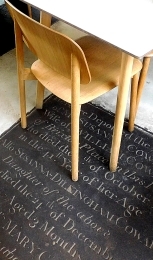 Café at The Garden Museum in London
Café at The Garden Museum in LondonThe café, completed in 2018, is at the east end of the Church of St Marys, Lambeth, which now serves as the home of The Garden Museum. The church stands next to the main Tudor entrance of Lambeth Palace. The tower was built in about 1378. The rest of the church contains structural elements that were built in later eras. Appropriately for a museum dedicated to gardening history, the repurposed Church of St Mary’s is the burial place of the famous gardener and plant collector, John Tradescant the Elder (c1570s-1638). It is also the final resting place of Captain William Bligh (1754-1817) of The Bounty Mutiny (1789) fame. This famous mariner owned a house in Lambeth. Customers of the café do not sit on the graves of these two well-known persons, but on gravestones that, unlike the graves at Lucky in Ahmedabad which are raised above the ground, are level with the rest of the café’s floor.
The graves at Lucky in Ahmedabad are coffin shaped and probably contain the remains of the deceased. I am not sure whether there are human remains beneath the grave slabs in the floor of the café in Lambeth. A young waiter, whom I asked, was concerned to reassure me that he believed that there are no skeletons beneath the gravestones upon which customers walk and sit. I wonder whether this is really the case.
The Garden Museum was founded in 1977 by Rosemary and John Nicholson in order to preserve the church, which was due for demolition (https://gardenmuseum.org.uk/the-museum/history/). In 2015, the museum was closed for a year and a half whilst it was being redeveloped. Part of the improvements made was the construction of an extension at the eastern end of the retired church. The new construction, designed by Christopher Bradley-Hole and Dan Pearson, includes the café and other structures that together surround a new courtyard that contains a lovely garden, The Sackler Garden designed by Dan Pearson. It contains several tombs including that of the Tradescant family and of Captain Bligh.
The café borders the western side of the courtyard. Its mainly glass walls provide good views of the garden, the buildings across the river and the leafy remains of the churchyard west of the café. Where there is no glass, the walls are covered with overlapping brown coloured metal panels. Serving great coffee and both snacks and meals, the legs of the chairs and tables rest on the gravestones that form part of the floor.
Compared with Lucky, which is in a very busy part of Ahmedabad, the Garden Museum café, although close to a busy main road, is far more peaceful. However, both are delightful places to enjoy refreshments.
November 4, 2021
Unveiled at last
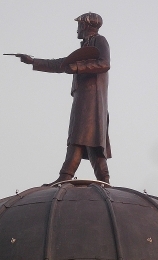
THE CORONET CINEMA in London’s Notting Hill Gate was renamed The Print Room a few years ago. Once a cinema, it is now a theatre. Like other theatres, it was closed for a long time during 2020 and early 2021 because of the covid19 lockdowns. During this prolonged period of closures, a statue was placed upon the dome that stands above the theatre’s main entrance. In my book “Walking West London” (freely available as a pdf file from https://adamyamey.co.uk/walking-west-london/), I wrote about the Coronet/Print Room as follows:
“… the former ‘Coronet Cinema’. This was designed as a theatre by WGR Sprague (1863-1933) who designed many of London’s theatres. It opened in 1908. By 1923, the Coronet had become a cinema, and remained so for many years. Apart from the screen, the fittings inside the auditorium were those of an unmodernised Edwardian theatre. Until smoking was banned in all public places, the Coronet was one of the last cinemas in London which permitted smoking (but only in the balcony seating). Between 2004 and 2014, the Coronet doubled up as both a branch of the Kensington Temple Church and, also, as a cinema. And, in 2015 the Coronet reverted to being used as a theatre, now called ‘The Print Room’. This sensitively restored theatre puts on interesting plays, which are well-produced. The bar, which is located beneath the stage in what was once the stalls area of the cinema, is worth visiting to see its ever changing, tastefully quirky décor. In 2020, the theatre was redecorated and a statue by the British sculptor Gavin Turk (born 1967) has been placed upon the dome above the building’s main entrance. The new artwork replaces one that was removed many decades ago.”
When I wrote this, the sculpture was enshrouded in a tarpaulin. Only recently, the covering has been removed and the sculpture can be seen in all its glory. The artwork depicts the artist Gavin Turk posing as the famous artist Sir Joshua Reynolds (1723-1792) just as he appears his sculptural in the Annenberg Courtyard of Burlington House in the grounds of the Royal Academy. When seen from the east, the new sculpture looks like a painter holding a palette and his brush. However, when seen from the west, the viewer might be led to believe that the statue is of a man holding a gun. I feel that the sculpture is a great addition to the landscape of Notting Hill Gate, but a bit too high above ground level to be able to see it easily with the unaided eye.
November 3, 2021
Wall of sorrow
PARLIAMENT’S HOME IS OPPOSITE a wall that runs along the northern edge of the grounds of London’s St Thomas’s Hospital. The wall is separated from the River Thames by a walkway, the embankment between Westminster and Lambeth bridges. Almost every square inch of the river facing side of the wall, which is about 440 yards in length, is covered by hand-painted hearts of various sizes and in various shades of red and pink. Many of the hearts have names, dates, and short, sad messages written on them.

Each of the many thousands of hearts painted on the wall (by volunteers) represents one of the huge number of people who died because of being infected with the covid19 virus. The wall is now known as The National Covid Memorial Wall and work on the painting commenced in March 2021. The mural that records the numerous tragic deaths was organised by a group known as Covid-19 Bereaved Families for Justice. The names and other information added to the hearts is being done by people who knew the bereaved person being remembered. When we walked past the wall today, the 27th of October 2021, we saw a young lady carefully writing on one of the hearts. Seeing this and the wall with all its reminders of the pandemic-related deaths was extremely depressing. On our return journey, I insisted that we crossed the river and walked along the opposite embankment on which the Houses of Parliament stands. Even from across the river, the reddish cloud of hearts on the wall is visible. Certainly, this would be the case from the riverside terraces accessible to those who work and govern within the home of Parliament.
It is ironic (and maybe deliberately so) that the wall with its many tragic reminders of deaths due to covid 19 is facing the Houses of Parliament (The Palace of Westminster), where had different decisions been taken, sooner rather than later, many of the names on the wall might not have needed to be written there.
November 2, 2021
Aphrodite and a spring
LONDON’S PARKS ARE filled with surprises of historical interest. The Terrace Gardens overlooking a bend in the River Thames at Richmond are no exception. A short path leads from a larger one to a cave in the side of a well vegetated slope. The entrance to the cave is topped with a semi-circular arch and its is closed by a locked iron gate. There is little to be seen inside the small cave. The pathway leading to the entrance is lined by barrel shaped concrete blocks
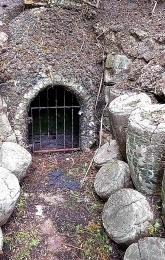
An informative plaque at the start of the path explains the history of this small, rather well-concealed cave, now known as Spring Well. From this we learn that the cave, formerly believed to have been an icehouse, was part of Richmond Wells. The latter were:
“…a place of entertainment from 1690 to 1750. In 1755, the buildings were demolished and replaced by Cardigan House as a residence for the sixth Earl of Cardigan.” (https://historicengland.org.uk/listing/the-list/list-entry/1001551).
The Wells were closed because local residents felt that they attracted rowdy and badly behaved visitors.
Cardigan House was purchased by John Willis (1820-1899) in the 19th century. Willis was the proprietor of a shipping company, John Willis & Sons of London, which owned several clippers. One of these boats, a tea clipper, can still be seen in its full glory downstream from Richmond at Greenwich: The Cutty Sark, visited by many tourists. The barrel shaped concrete blocks near the entrance to the cave are possibly, according to the information panel nearby, moulded from barrels carried by the Cutty Sark. I like the idea, but who knows whether this was really the case after such a long time.
Near to the now disused spring, another surprise awaits the visitor. It is a sculpture of a voluptuous naked woman seated on a dolphin. Carved in Portland stone in 1952 by Allan Howe, she depicts the goddess Aphrodite (‘Venus’ in Latin). From her seat on the dolphin, the goddess has a wonderful view of the Thames far below her. When she was unveiled, many locals regarded her as being in ‘bad taste’, but she has survived the test of time and is perfectly acceptable nowadays. A statue of Aphrodite might not be regarded as a great surprise in a park, but the local people’s name for here, ‘Bulbous Betty’, might be.
November 1, 2021
A bridge near Regents Park
PARKWAY LEADS GENTLY uphill from Camden Town Underground station to a short road called Gloucester Gate, which leads to the Outer Circle that runs around Regents Park. Much of Gloucester Terrace runs along what looks like a bridge, which is lined on its north side by red-coloured, decorative stone parapet.
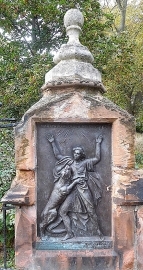 St Pancras, Regents Park, London
St Pancras, Regents Park, LondonThe bridge traverses a grassy dell that does not appear to contain any kind of watercourse. I wondered why such an elaborate bridge had been built to traverse what appears to be merely a grassy hollow. Well, when it was built, it did cross a waterway, the Cumberland Market Branch of the Regent’s Canal known as ‘The Cumberland Arm’ (www.londonslostrivers.com/cumberland-arm.html). This waterway, built in 1816, ran for about half a mile from the Regents Canal to a basin near Euston Station, running for most of its length parallel to Albany Street. During WW2, the Cumberland Arm, which had up until then been used to transport freight, was used to supply water to firefighting appliances. By the end of the war, the canal had been filled with rubble from buildings destroyed by bombing and then covered with topsoil. All that remains of the Cumberland Arm is a short blind-ending stretch of water near Regents Park Road, on which there is a large floating Chinese restaurant and a few moorings for narrow boats.
The Gloucester Gate bridge with its decorative parapet and elaborate cast-iron lampstands also includes two interesting memorials. One of these relates to the fact that the bridge was constructed by the St Pancras Vestry, the then local authority governing the area (www.andrewwhitehead.net/blog/the-most-pointless-bridge-in-london). There is a bronze bas-relief depicting the martyrdom of St Pancras. It was a gift of William Thornton and sculpted by the Italian Ceccardo Egidio Fucigna (c1836-1884), who died in London. St Pancras (c289-303/4) was born a Roman citizen. He converted to Christianity and was beheaded for his beliefs when he was 14 years old (https://en.wikipedia.org/wiki/Pancras_of_Rome). The bronze relief on Gloucester Gate bridge shows a young man being mauled by an animal, possibly a lion. Why this motif was chosen when the saint was beheaded puzzles me.
Near the St Pancras panel, also on the bridge, there is an old but elaborate drinking fountain. A metal plate attached to it has faded letters that read:
“Saint Pancras Middlesex.
This fountain and works connected therewith were presented to the Metropolitan Drinking Fountain Association on the (?) day of August 1878 by
Matilda
Richard Kent esq. Junior Churchwarden 1878.
The figure … cast in bronze was designed by Joseph Durham ARA.” (https://victorianweb.org/sculpture/durham/1c.html)
The fountain, known as ‘The Matilda Fountain’, is part of a miniature cave made with granite boulders. A sculpture of a milkmaid stands above the cave. At her feet, there is a wooden pail with two handles. The girl with a rich crop of hair on her head is depicted shielding her eyes from the sun with her right hand as she stares into the distance. Cast in bronze, the female figure and the pail were sculpted by Joseph Durham (1814-1877). Matilda might possibly have been Richard Kent’s wife, but the plaque does not specify this. The sculpture is not unique; several other copies of it, all by Durham, exist. One of these, dated 1867 and called “At the Spring/Early Morn”, can be seen in Blackburn’s Town Hall (https://victorianweb.org/sculpture/durham/1d.html).
Today, the bridge is redundant since the canal was filled-in long ago. However, it is used by many people walking to and from Regents Park and its zoo and a steady stream of vehicular traffic crosses it. Although it has outlived its original purpose, the bridge serves as a reminder of a once important element of London’s continuously evolving transportation system.
October 31, 2021
In the footsteps of Mahatma Gandhi
RECENTLY, I WALKED in Mahatma Gandhi’s footsteps, neither in India nor in South Africa nor in London, but in southeast England.
I am sure that many years ago, at least once, I travelled by ferry across the English Channel from Folkestone in Kent to a port in France. Whether I was travelling by car or by train I cannot recall. Had I been travelling by rail I feel sure that I would have remembered the pier at Folkestone, but I cannot now recall it. If I reached the ferry by train, it would have had to have been before 2001, when the last ferry sailed from Folkestone.
The first ferry service from Folkestone to Boulogne began in 1843 (https://folkestoneharbourarm.co.uk/history/the-harbour-in-the-19th-century/). Passengers reached the boat from the mainline railway station by local transport. In 1847, a long viaduct was constructed to take a steeply inclined mile long branch line from the main line, which was 111 feet above sea level, to the shoreline. This track crossed the viaduct and a swing bridge, which still exist and separate the Inner harbour from the Outer Harbour. At the seashore, the track ran onto a newly constructed pier, The Harbour Arm, from which passengers and freight could be embarked and disembarked. The pier, which was only fully completed in 1904, had a station, a customs house, and warehousing facilities.
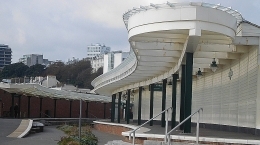
During WW1, the Harbour Arm played an important role in the conveyance of military personnel and materials between war-torn Europe and the UK. In December 1915, the famous spy Margaretha Geertruida Zelle (‘Mata Hari’; 1876-1917) was prevented from boarding a vessel at Folestone bound for France by Captain S Dillon of the Secret Intelligence Service. Another famous person, of far greater historical significance than Mata Hari, stepped of a vessel, the SS Biarritz, onto the Harbour Arm on the 12th of September 1931. This passenger was a Gujarati, the only member of the Indian National Congress, Mohandas K Gandhi (1869-1948), going to London to attend the Round Table Conference. A picture taken at the time (www.alamy.com/mahatma-gandhi-alighting-at-folkestone-kent-england-united-kingdom-uk-12-september-1931-old-vintage-1900s-picture-image346793736.html) shows him, dressed in white robes and a dhoti, stepping along a gangplank. The curved platform of the station on the pier, which still exists, is clearly visible in the picture. He is shown walking towards a group of policemen and reporters, some of whom are holding unfurled umbrellas. His arrival at Folkestone on a rainy day is also recorded in a short but amusingly commentated newsreel film (https://youtu.be/P6njRwz_dMw), which also illustrates the rapturous reception he received in the streets of London.
Far more recently, another arrival at Folkestone has hit the headlines. On the 19th of October 2021, a large puppet called Little Amal (‘amal’ meaning ‘hope’ in Arabic), over ten feet in height, first made its appearance in the UK in Folkestone. Little Amal has been carried on foot all the way across Europe from Turkey (www.creativefolkestone.org.uk/whats-on/the-walk-one-little-girl-one-big-hope/) as part of an exercise to raise the public awareness of the plights of refugee children fleeing their native lands. On British soil, she plans to tour the country for a while. Little Amal did not arrive, as Gandhi did, on a cross-channel ferry bound for Folkestone, but she did make her first an appearance on the Harbour Arm (www.kentonline.co.uk/folkestone/news/little-amal-coming-to-town-255932/). She was greeted by the actor Jude Law.
Folkestone harbour was heavily bombed during WW2 and then the pier was repaired after the war ended. Passenger services to France resumed in 1946, but limitations of the harbour’s depth, which prevented the docking of larger ferries, and the development of roll, on roll-off ports elsewhere, led to Folkestone’s gradual decline as a port. These factors and the completion of the nearby Channel Tunnel resulted in the ending of Folkestone’s life as a passenger port by 2000. After this date, the Harbour Arm and its buildings fell into decline and became dilapidated.
In 2014, the Department of Transport closed the railway line ad the facilities on the Harbour Arm. The following year, it was acquired by the Folkestone Harbour & Seafront Development Company (www.folkestoneseafront.com/). This organisation has tastefully restored the Harbour Arm and its buildings as well as the viaduct leading to it across the water. The rails on the viaduct have been preserved but submerged in the walkway in such a way that their top surfaces can be seen. The sinuous platforms and their canopies have been repaired, as have the signal box (now a café) and the old Customs House. Beyond the station, the pier runs out to sea towards a lighthouse. All along the pier, there are several eateries. Also, there is an artwork by Antony Gormley. What was once a busy transport hub has now become a delightful leisure facility, which along with Folkestone’s transformation as an artistic ‘creative hub’ has turned the town into a place well worth visiting, a far cry from what it was when Gandhi set foot on its pier. My wife and I wondered whether Little Amal, who is quite tall, will have as much influence on the future of the world as did the short man from India, who arrived in his dhoti at Folkestone in 1931.
I am pleased to have walked where Gandhi once stepped in Folkestone because I have also followed in his footsteps in various places in India including his birthplace Porbandar in Gujarat, Rajkot, Bhavnagar, Bombay, Madras, and Bangalore. In London, I have often walked by Friends House on Euston Road, passing the very door through which he left the building to greet his admirers back in 1931. In all these places, there are ample monuments and other reminders of the Great Soul (the Mahatma), but, as far as I know, Folkestone is yet to materially commemorate his brief presence there.
October 30, 2021
Street market in Portobello Road
THIS IS AN EXTRACT from my latest book, “Walking West London”, which can be downloaded in its entirety (as a pdf file), free of charge and with no strings attached, from: https://adamyamey.co.uk/walking-west-london/ (just click on the green button, labelled “Download”). The sample below relates to the street market on Portobello Road:
NO LONGER A COUNTRY LANE (PORTOBELLO)

Lovers of street markets, whether they be searching for antiques, bric-abrac, jewellery, telephone covers, clothing, snacks, cafés, flowers, fruit, or vegetables, will enjoy browsing the diverse stalls and small shops that line Portobello Road. This street, which used to be called ‘Portobello Lane’ runs from Notting Hill Gate to just south of the main railway line that begins at Paddington Station. In days gone by, it ran from the gravel pits at Notting Hill Gate to the now long-since demolished Portobello Farm,which stood roughly between Orchard Close and Blagrove Road in NorthKensington.
Before the mid-19th century Portobello Lane, as it was then called, was to quote the historians Florence Gladstone and Ashley Barker (writing in1924):
“‘… one of the most rural and pleasant walks in the summer in the vicinity of London’, and within living memory it led ‘through fields to Kensal Green … cornfields and meadow land on each side … ‘”
Well, Portobello Road is no longer bucolic. It is lined with buildings along its entire length. Currently, it begins with a short section that leads off Pembridge Villas. It is here that you can stop for a drink at the Sun inSplendour pub, which was built in the early 1850s. After running a few yards westwards, Portobello Road heads off in a north-westerly direction, which it maintains with barely any deviation for the rest of its length. Number 22 was the first London home of the writer George Orwell. He lived there as a lodger in the winter of 1927.
After crossing Chepstow Villas, the road slopes downwards and soon after this the market area commences. On most weekdays, much of the market is dedicated to daily domestic needs, mostly food. On Fridays and Saturdays, the number of stalls and the variety of goods on offer increases dramatically. In normal times (i.e., when there is no pandemic), Portobello Road is choked with crowds of people from all over the world, especially on Saturdays.
In the 1860s, the Metropolitan Line (now the ‘Hammersmith and City Line’) was built. It crosses Portobello Road close to the Ladbroke Road station, which was originally known as ‘Notting Hill’ station. Rail access probably accounted for the urban development of what was once ‘Portobello Lane’. The market in Portobello Road probably began operating in the second half of the 19th century. Until the 1940s, it served people’s daily needs. Then, in the 1940s, traders selling anything from junk to antiques began trading along the road, alongside the purveyors of daily requirements, and that has how it has remained.
The architecture of Portobello Road is far from distinguished. Much of it is ‘bog standard’ Victorian suburban sprawl, but this is hardy disturbing as the eye has plenty of other things to distract it along the multicultural, bustling, colourful, sometimes quirky market street.
Next, I will point out several things worth noticing if you can take your eyes off the shops, the buskers, and the stalls in the market. The Electric Cinema on Portobello Road was first opened in 1910, making it one of the oldest still working cinemas in the UK. It was one of the first buildings in the area to receive a supply of electricity. It has an Edwardian façade. Despite having been closed for several short periods during its lifetime, it still shows films. Since its extensive repairs in 2000, it has become a luxurious space in which to watch films. It is near to Talbot Road that leads to the church of All Saints.
The Victorian church was built between 1852 and 1861 …
END OF SAMPLE. If you have enjoyed it, please download a copy of my book to learn more about London west of Park Lane.
October 29, 2021
An invisible abbey and Vietnamese food
THERE IS A SUPERB Vietnamese eatery on London’s Bermondsey Street, called Caphe House. After eating a tasty banh mi, a baguette filled with meat and fresh vegetable, a dish no doubt inspired by the French occupation of Vietnam, and a pho, a clear broth with meat, vegetables, and noodles, we crossed the road to examine a sculpture. This eye-catching artwork had not been present when last visited Caphe House, sometime before the pandemic and well before October 2019. It consists of a row of seven piles of stone carvings of differing heights, resembling short totem poles. Made of Portland stone, Bath stone, marble and other materials found in the River Thames, this was created in 2020 by Austin Emery and members of the local community. Over 100 members of the community made carvings in a workshop, and these have been assembled by Emery to create what we saw, an artwork named “Cornerstone”. Cornerstone also incorporates fragments from Southwark Cathedral, Westminster Abbey, London Bridge Station, and bones from the Thames.
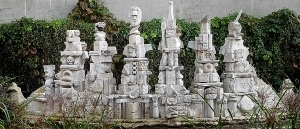 Cornerstone, a sculpture in London’s Bermondsey
Cornerstone, a sculpture in London’s BermondseyAfter admiring this unusual and intriguing sculpture, I spotted a notice nearby. It relates to the history of Tanner Park, where the sculpture stands, and includes the following:
“… Originally part of the grounds of Bermondsey Abbey the site of the Park was later in use as a Tannery …”
Reading this notice, I realised that this was the first time I had seen mention of an abbey at Bermondsey.
There had been an abbey in Bermondsey since the early 9th century (https://en.wikipedia.org/wiki/Bermondsey_Abbey). This was centred on the site of the present-day Bermondsey Square, about 390 yards south of the Cornerstone sculpture. The abbey to which the notice at Tanner Park refers was a Benedictine abbey, which was dedicated to St Saviour and was founded in the early 11th century. A wealthy religious establishment, it was, like so many other similar institutions, dissolved by King Henry VIII in the 16th century, in 1537. But where was it?
By 1822, only tiny fragments of the abbey were still standing. Today, nothing remains, although occasional archaeological digs have exposed parts of it, albeit temporarily. Fathome’s map of Southwark compiled in 1643-48 shows that then the abbey was still standing intact in its grounds (https://www.british-history.ac.uk/old-new-london/vol6/pp117-133). According to one writer (https://knowyourlondon.wordpress.com/2018/07/06/bermondsey-abbey/), who does not give the source(s) of his information, the site of the abbey was:
“The abbey lands extended from the present church of St Mary Magdalene, across today’s Tower Bridge Road.”
A map included by this writer marks the abbey church as lying along Abbey Street with the nave to the west of Tower Bridge Road and the chancel east of it. A wall plaque (www.londonremembers.com/memorials/ber...) which I have not yet seen informs that the abbey:
“… occupied ground between Bermondsey Street, Abbey Street, and Grange Walk…”
The church of St Mary Magdalen stands on Bermondsey Street just before its crossing with Abbey Street. This stands on the site of a church that existed in 1290 and which served lay workers of the abbey. This was demolished in 1680, but the late mediaeval tower was kept. It was rebuilt ten years later. During the 19th century, the exterior was covered with rendering and various other architectural modifications were made both internally and externally (https://en.wikipedia.org/wiki/St_Mary_Magdalen_Bermondsey). Apparently, the church’s mediaeval arches are visible inside the tower behind the organ and the church also contains some mediaeval stone capitals that might well have been parts of Bermondsey Abbey. St Mary Magdalen is the oldest surviving building in the area. It is open occasionally. I have entered it once, but that was long before I knew about the mediaeval remnants it contains.
Despite the fact that Bermondsey Abbey is now merely a historical memory, Bermondsey Street is an interesting place to visit. Amongst its attractions are Peter Layton’s glass studio, where you can watch glassblowers creating fantastic artworks in glass; Rachel Eames Gallery, which often has good exhibitions of contemporary artists’ works; The Fashion and Textile Museum; The White Cube (Bermondsey), which hosts spectacular shows of contemporary art; and the Cornerstone sculpture, described already. I suggest starting your visit with an early lunch at Caphe House, rounding it off with Vietnamese filter coffee, and ending it with another good coffee at the cheekily named, quirkily decorated Fuckoffee café.

